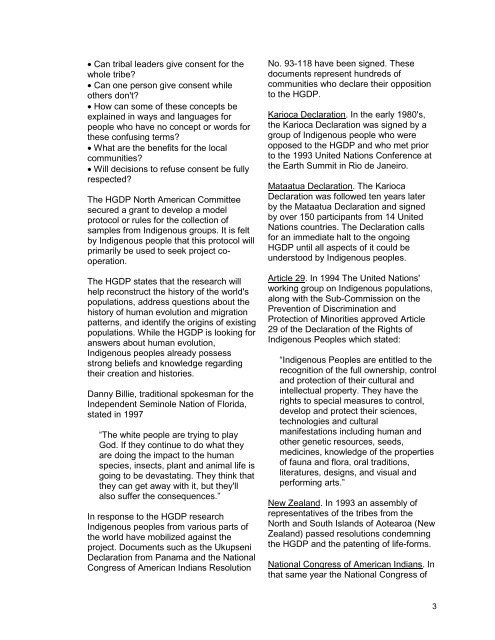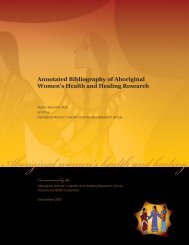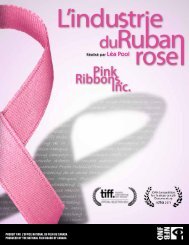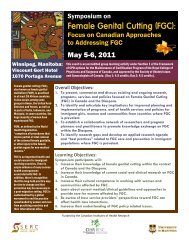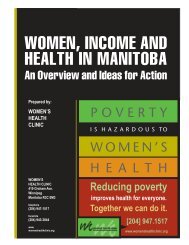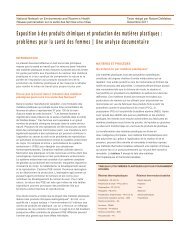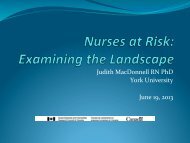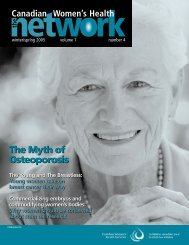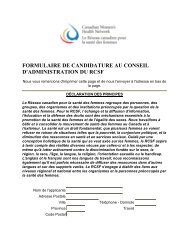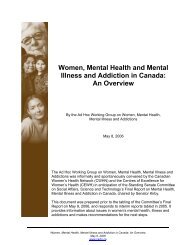from Priscilla Settee - Canadian Women's Health Network
from Priscilla Settee - Canadian Women's Health Network
from Priscilla Settee - Canadian Women's Health Network
- No tags were found...
Create successful ePaper yourself
Turn your PDF publications into a flip-book with our unique Google optimized e-Paper software.
• Can tribal leaders give consent for thewhole tribe?• Can one person give consent whileothers don't?• How can some of these concepts beexplained in ways and languages forpeople who have no concept or words forthese confusing terms?• What are the benefits for the localcommunities?• Will decisions to refuse consent be fullyrespected?The HGDP North American Committeesecured a grant to develop a modelprotocol or rules for the collection ofsamples <strong>from</strong> Indigenous groups. It is feltby Indigenous people that this protocol willprimarily be used to seek project cooperation.The HGDP states that the research willhelp reconstruct the history of the world'spopulations, address questions about thehistory of human evolution and migrationpatterns, and identify the origins of existingpopulations. While the HGDP is looking foranswers about human evolution,Indigenous peoples already possessstrong beliefs and knowledge regardingtheir creation and histories.Danny Billie, traditional spokesman for theIndependent Seminole Nation of Florida,stated in 1997“The white people are trying to playGod. If they continue to do what theyare doing the impact to the humanspecies, insects, plant and animal life isgoing to be devastating. They think thatthey can get away with it, but they'llalso suffer the consequences.”In response to the HGDP researchIndigenous peoples <strong>from</strong> various parts ofthe world have mobilized against theproject. Documents such as the UkupseniDeclaration <strong>from</strong> Panama and the NationalCongress of American Indians ResolutionNo. 93-118 have been signed. Thesedocuments represent hundreds ofcommunities who declare their oppositionto the HGDP.Karioca Declaration. In the early 1980's,the Karioca Declaration was signed by agroup of Indigenous people who wereopposed to the HGDP and who met priorto the 1993 United Nations Conference atthe Earth Summit in Rio de Janeiro.Mataatua Declaration. The KariocaDeclaration was followed ten years laterby the Mataatua Declaration and signedby over 150 participants <strong>from</strong> 14 UnitedNations countries. The Declaration callsfor an immediate halt to the ongoingHGDP until all aspects of it could beunderstood by Indigenous peoples.Article 29. In 1994 The United Nations'working group on Indigenous populations,along with the Sub-Commission on thePrevention of Discrimination andProtection of Minorities approved Article29 of the Declaration of the Rights ofIndigenous Peoples which stated:“Indigenous Peoples are entitled to therecognition of the full ownership, controland protection of their cultural andintellectual property. They have therights to special measures to control,develop and protect their sciences,technologies and culturalmanifestations including human andother genetic resources, seeds,medicines, knowledge of the propertiesof fauna and flora, oral traditions,literatures, designs, and visual andperforming arts.”New Zealand. In 1993 an assembly ofrepresentatives of the tribes <strong>from</strong> theNorth and South Islands of Aotearoa (NewZealand) passed resolutions condemningthe HGDP and the patenting of life-forms.National Congress of American Indians. Inthat same year the National Congress of3


